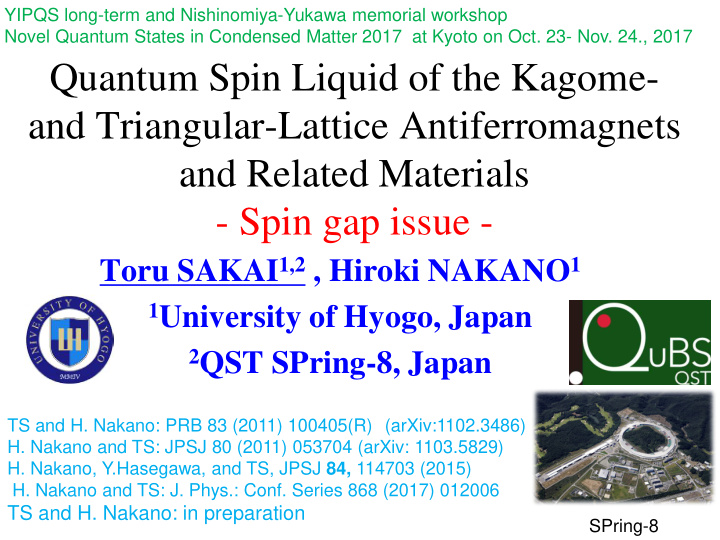



YIPQS long-term and Nishinomiya-Yukawa memorial workshop Novel Quantum States in Condensed Matter 2017 at Kyoto on Oct. 23- Nov. 24., 2017 Quantum Spin Liquid of the Kagome- and Triangular-Lattice Antiferromagnets and Related Materials - Spin gap issue - Toru SAKAI 1,2 , Hiroki NAKANO 1 1 University of Hyogo, Japan 2 QST SPring-8, Japan TS and H. Nakano: PRB 83 (2011) 100405(R) (arXiv:1102.3486) H. Nakano and TS: JPSJ 80 (2011) 053704 (arXiv: 1103.5829) H. Nakano, Y.Hasegawa, and TS, JPSJ 84, 114703 (2015) H. Nakano and TS: J. Phys.: Conf. Series 868 (2017) 012006 TS and H. Nakano: in preparation SPring-8
Candidates of Quantum Spin Fluid 2D frustrated systems = ∑ ⋅ H J S i S • S=1/2 Heisenberg antiferromagnets j , i j Triangular lattice Kagome lattice 120 degree LRO No (conventional) LRO
Kagome lattice Itiro Syôzi: Statistics of Kagomé Lattice, PTP 6 (1951)306 kagome Corner sharing triangles
S=1/2 Kagome Lattice AF • Herbertsmithite ZnCu 3 (OH) 6 Cl 2 impurities Shores et al. J. Am. Chem. Soc. 127 (2005) 13426 • Volborthite CuV 2 O 7 (OH) 2 ・ 2H 2 O lattice distortion Hiroi et al. J. Phys. Soc. Jpn. 70 (2001) 3377 • Vesignieite BaCu 3 V 2 O 8 (OH) 2 ideal ? Okamoto et al. J. Phys. Soc. Jpn. 78 (2009) 033701
Spin gap issue of kagome-lattice AF Gapped theories Valence Bond Crystal (VBC) MERA[Vidal] Z 2 Topological Spin Liquid [Sachdev (1992)] DMRG [White (2011)] Chiral Liquid [Messio et al. PRL 108 (2012) 207204] Gapless theories U(1) Dirac Spin Liquid[Ran et al. PRL 98 (2007) 117205] Variational method [ Iqbal, Poilblanc, Becca, PRB 89 (2014) 020407 ] DMRG [He et al. PRX 7 (2017) 031020]
Single crystal of herbertsmithite T. Han, S. Chu, Y. S. Lee: PRL 108 (2012) 157202 ZnCu 3 (OH) 6 Cl 2 Inelastic neutron scattering: Spin gap < J/70 Gapless M. Fu, T. Imai, T.-H. Han, Y. S. Lee: Science 350 (2015) 655 NMR : Gapped
Methods Frustration Exotic phenomena Kagome lattice Triangular lattice Pyrochlore lattice Numerical approach Numerical diagonalization Quantum Monte Carlo (negative sign problem) Density Matrix Renormalization Group (not good for dimensions larger than one)
Computational costs N =42, total Sz=0 Dimension of subspace d = 538,257,874,440 Δ = 0.14909214 cf. A. Laeuchli cond-mat/1103.1159 Memory cost d * 8 Bytes * at least 3 vectors ~ 13TB 4 vectors ~ 20TB Time cost d * # of bonds * # of iterations d increases exponentially with respect to N . Parallelization with respect to d
Numerical diagonalizations of finite-size clusters up to N s =42 Important to divide data into two groups of odd N s even N s and odd N s . rhombic Not good to treat all the data together. non-rhombic even N s
Analysis of our finite-size gaps H. Nakano and TS: JPSJ 80 (2011) 053704 (arXiv: 1103.5829) ∆ /J=A+Bexp(-CN s ∆ /J=A+B/(N s 1/2 ) 1/2 ) Two extrapolated results disagree gapless is better ! from odd N s and even N s sequences.
Gapless or Gapped ? Susceptibility analysis Field derivative of magnetization at M=0 as a function of
∑ ∑ = ⋅ − µ ˆ (g μ B =1) z H J S S H S g i j B j i , j j ↓ ↓ M= Σ j S j z E(M) - HM E(M)/N ~ ε(m) (N→∞) m=M/N E(M+1)-E(M) ~ ε ’(m) + ε ’’(m)/2N + ・・・ (E(M+1)-E(M))-(E(M)-E(M-1)) ~ ε ’’(m)/N m=0 ↓ 2 Δ ~ ε ’’(m)/N χ = dm/dh =1/ ε’’(m)→0 for Δ≠0 N →∞
Demonstration of analysis Dimerized Square Lattice J 1 α = J 2 / J 1 J 2 α =1: square lattice, LRO, gapless α =0.52337(3): critical Matsumoto et al: PRB 65 (2001) 014407 α =0: isolated dimers gapped
Magnetization processes Gapless Gapped
Differential susceptibility vs. M Gapped Gapless
Size dependence of χ at M=0 Gapless Gapped
Kagome-lattice Heisenberg AF
Kagome lattice AF Differential susceptibility vs. M N s =39 N s =36 N s =42
Size dependence of χ at M=0 N s =30 N s =12 N s =36 N s =18 N s =24 N s =42 χ→ finite (N s →∞) ⇒ Gapless
Triangular lattice AF Size dependence of χ N s =18 N s =30 N s =12 N s =36 N s =24 Consistent with gapless feature of triangular lattice AF
Conclusion • “Susceptibility analysis” confirmed that S=1/2 kagome-lattice AF is gapless, as well as S=1/2 triangular-lattice AF. • In order to confirm it, we should do the numerical diagonalization of larger-size clusters than 42 spins. K-Computer
1/3 magnetization plateau of triangular lattice AF S=1/2 Heisenberg AF N=39 36 27 Order from disorder
Next-nearest-neighbor interactions J 1 A B C J 2 J 2 J 2
Purpose of this study is to study how the m=1/3 state behaves when the next-nearest-neighbor interaction is controlled. J 2 J 1 r=J 2 /J 1
Possible finite-size clusters N=27(=3*9) N=36(=3*12)
Magnetization curves J 2 /J 1 =2.2 J 2 /J 1 =0.1 J 2 /J 1 =0.3
Analysis of plateau width N=36 120-degree structure + N=27 120-degree structure 120-degree + structure 120-degree structure gapped gapped gapless
Summary S=1/2 Heisenberg antiferromagnet on the triangular lattice with next-nearest-neighbor interactions Numerical-diagonalization method The m=1/3 plateau disappears between weak-J 2 and strong-J 2 regions. H. Nakano and TS, J. Phys. Soc. Jpn. 86 (2017) 114705 (arXiv: 1708.07248)
Recommend
More recommend